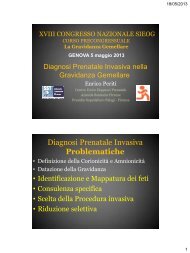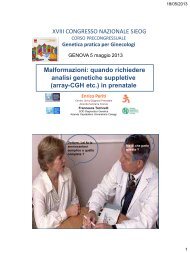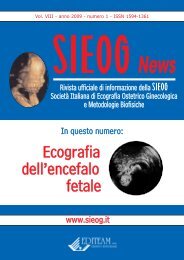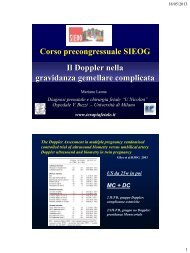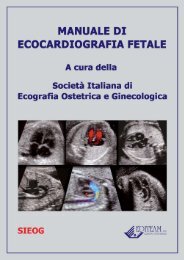Sieog 2-2008
Sieog 2-2008
Sieog 2-2008
You also want an ePaper? Increase the reach of your titles
YUMPU automatically turns print PDFs into web optimized ePapers that Google loves.
4. Petrou S.The economic consequences of preterm birth during<br />
the first 10 years of life. BJOG 2005; 112 (Suppl. 1): 10-15.<br />
5. Romero R e coll.The preterm labor syndrome. Ann. NY Acad.<br />
Sci. 1994; 734: 414-429.<br />
6. Romero R e coll.The preterm parturition syndrome. BJOG 2007;<br />
113 (Suppl. 3): 17-42.<br />
7. Tiret L. Gene-environment interaction: a central concept in multifactorial<br />
diseases. Proc. Nutr. Soc. 2002; 61: 457-463.<br />
8. Adams K e coll.The genetic contribution towards preterm delivery.<br />
Semin. Fetal Neonatal. Med. 2004; 9: 445-452.<br />
9. Goldenberg R e coll.The preterm prediction study: the value of<br />
new vs standard risk factors in predicting early and all spontaneous<br />
preterm births. Am. Public Health. 1998; 88: 233-238.<br />
10. Nicolaides K. Some thoughts on the true value of ultrasound. Ultrsound<br />
Obstet. Gynecol. 2007; 30: 671-674.<br />
11. Horsch S e coll. Brain abnormalities in extremely low gestational<br />
age infants: a Swedish population based MRI study. Acta Paediatrica<br />
2007; 96: 979-984.<br />
12. Iams J e coll.The length of the cervix and the risk of spontaneous<br />
premature delivery. N. Engl. J. Med. 1996; 334: 567-572.<br />
13. Buekens P e coll. European Community Collaborative Study<br />
Group on prenatal screening. Randomized controlled trial of routine<br />
cervical examinations in pregnancy. Lancet 1994; 344: 841-844.<br />
14. Heath V e coll. Cervical length at 23 weeks of gestation: prediction<br />
of spontaneous preterm delivery. Ultrasound Obstet. Gynecol.<br />
1998; 12: 312-317.<br />
15. Hassan S e coll. Patients with an ultrasonographic cervical length<br />
< or =15 mm have nearly a 50% risk of early spontaneous preterm<br />
delivery. Am. J. Obstet. Gynecol. 2000; 182: 1458-1467.<br />
16. Taipale P e coll. Sonographic measurement of uterine cervix at<br />
18-22 weeks’ gestation and the risk of preterm delivery. Obstet. Gynecol.<br />
1998; 92: 902-907.<br />
17. To M e coll. Prediction of patient-specific risk of early preterm<br />
delivery using maternal history and sonographic measurement of cervical<br />
length: a population-based prospective study. Ultrasound Obstet.<br />
Gynecol. 2006; 27: 362-367.<br />
18. Guzman E e coll. Longitudinal assessment of endocervical canal<br />
length between 15 and 24 weeks’ gestation in women at risk for pregnancy<br />
loss or preterm birth. Obstet. Gynecol. 1998; 92: 31-37.<br />
19. Berghella V e coll. Prediction of preterm delivery with transvaginal<br />
ultrasonography of the cervix in patients with high-risk pregnancies:<br />
does cerclage prevent prematurity? Am. J. Obstet. Gynecol. 1999;<br />
181: 809-815.<br />
20. Guzman E e coll.A comparison of sonographic cervical parameters<br />
in predicting spontaneous preterm birth in high-risk singleton gestations.<br />
Ultrasound Obstet. Gynecol. 2001; 18: 204-210.<br />
21. Airoldi J e coll.Transvaginal ultrasonography of the cervix to predict<br />
preterm birth in women with uterine anomalies. Obstet. Gynecol.<br />
2005; 106: 553-536.<br />
22. Owen J e coll. Mid-trimester endovaginal sonography in women<br />
at high risk for spontaneous preterm birth. JAMA 2001; 286: 1340-<br />
1348.<br />
23. Celik E e coll. Cervical length and obstetric history predict spontaneous<br />
preterm birth: development and validation of a model to pro-<br />
VII<br />
vide individualized risk assessment. Ultrasound Obstet. Gynecol. <strong>2008</strong>;<br />
31: 549-554.<br />
24. Tongsong T e coll. Single transvaginal sonographic measurement<br />
of cervical length early in the third trimester as a predictor of preterm<br />
delivery. Obstet. Gynecol. 1995; 86: 184-187.<br />
25. Berghella V e coll. Cervical ultrasonography compared with manual<br />
examination as a predictor of preterm delivery. Am. J. Obstet.<br />
Gynecol. 1997; 177: 723-730.<br />
26. Tsoi E e coll. Sonographic measurement of cervical length in<br />
threatened preterm labor in singleton pregnancies with intact membranes.<br />
Ultrasound Obstet. Gynecol. 2005; 25: 353-356.<br />
27. Crane J e coll.Transvaginal sonographic measurement of cervical<br />
length to predict preterm birth in asymptomatic women at increased<br />
risk: a systematic review. Ultrasound Obstet. Gynecol. <strong>2008</strong>;<br />
31: 579-587.<br />
28. Mesiano S. Myometrial progesterone responsiveness and the control<br />
of human parturition. J. Soc. Gynecol. Investig. 2004; 11: 193-202.<br />
29. O’Brien J e coll. Progesterone vaginal gel for the reduction of recurrent<br />
preterm birth: primary results from a randomized, doubleblind,<br />
placebo-controlled trial. Ultrasound Obstet. Gynecol. 2007; 30:<br />
687-696.<br />
30. Fonseca E e coll. Progesterone and the risk of preterm birth<br />
among women with a short cervix. N. Engl. J. Med. 2007; 357: 462-<br />
469.<br />
31. De Franco EA e coll.Vaginal progesterone is associated with a<br />
decrease in risk for early preterm birth and improved neonatal outcome<br />
in women with a short cervix: a secondary analysis from a randomized,<br />
double-blind, placebo-controlled trial. Ultrasound Obstet.<br />
Gynecol. 2007; 30: 697-705.<br />
32. Espinoza J e coll.The prevalence and clinical significance of amniotic<br />
fluid ‘sludge’ in patients with preterm labor and intact membranes.<br />
Ultrasound Obstet. Gynecol. 2005; 25: 346-352.<br />
33. Bujold E e coll. Intra-amniotic sludge, short cervix, and risk of preterm<br />
delivery. J. Obstet. Gynaecol. Can. 2006; 28: 198-202.<br />
34. Romero R e coll.What is amniotic fluid ‘sludge’? Ultrasound Obstet.<br />
Gynecol. 2007; 30: 793-798.<br />
35. Kusanovic J e coll. Clinical significance of the presence of amniotic<br />
fluid ‘sludge’ in asymptomatic patients at high risk for spontaneous<br />
preterm delivery. Ultrasound Obstet. Gynecol. 2007; 30: 706-714.<br />
36. Gomez R e coll. Cervicovaginal fibronectin improves the prediction<br />
of preterm delivery based on sonographic cervical length in patients<br />
with preterm uterine contractions and intact membranes.Am.<br />
Obstet. Gynecol. 2005; 192: 350-359.<br />
37. Smith V e coll.A systematic review and quality assessment of systematic<br />
reviews of fetal fibronectin and transvaginal length for predicting<br />
preterm birth. Eur. J. Obstet. Gynecol. Reprod. Biol. 2007; 133:<br />
134-142.<br />
38. Paternoster D e coll. Cervical phIGFBP-1 in the evaluation of the<br />
risk of preterm delivery. Acta Obstet. Gynecol. Scand. 2007; 86: 151-<br />
155.<br />
39. Ting H e coll. Comparison of Bedside Test Kits for Prediction of<br />
Preterm Delivery: Phosphorylated Insulin-like Growth Factor Binding<br />
Protein-1 (pIGFBP-1) Test and Fetal Fibronectin Test. Ann. Acad.<br />
Med. Singapore 2007; 36: 399-402.



